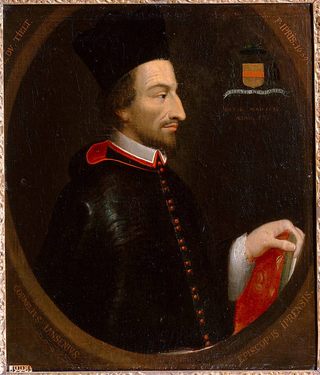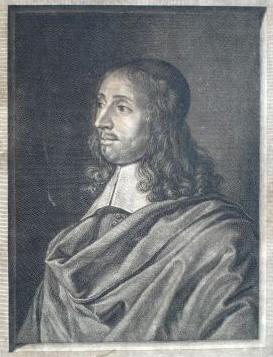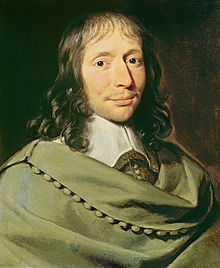
The Vulgate is a late-4th-century Latin translation of the Bible.

Jansenism was a 17th- and 18th-century theological movement within Roman Catholicism, primarily active in the Kingdom of France, which arose as an attempt to reconcile the theological concepts of free will and divine grace, in response to certain developments in the Roman Catholic Church, later developing political and philosophical aspects in opposition to royal absolutism.

Richard Simon CO, was a French priest, a member of the Oratorians, who was an influential biblical critic, orientalist and controversialist.

Antoine Isaac, Baron Silvestre de Sacy, was a French nobleman, linguist and orientalist. His son, Ustazade Silvestre de Sacy, became a journalist.

Port-Royal-des-Champs was an abbey of Cistercian nuns in Magny-les-Hameaux, in the Vallée de Chevreuse southwest of Paris that launched a number of culturally important institutions.

Antoine Arnauld was a French Catholic theologian, philosopher and mathematician. He was one of the leading intellectuals of the Jansenist group of Port-Royal and had a very thorough knowledge of patristics. Contemporaries called him le Grand to distinguish him from his father.

Anne-Geneviève de Bourbon was a French princess who is remembered for her beauty and amours, her influence during the civil wars of the Fronde, and her final conversion to Jansenism.

Pasquier Quesnel, CO was a French Jansenist theologian.

The Lettres provinciales are a series of eighteen letters written by French philosopher and theologian Blaise Pascal under the pseudonym Louis de Montalte. Written in the midst of the formulary controversy between the Jansenists and the Jesuits, they are a defense of the Jansenist Antoine Arnauld from Port-Royal-des-Champs, a friend of Pascal who in 1656 was condemned by the Faculté de Théologie at the Sorbonne in Paris for views that were claimed to be heretical. The first letter is dated January 23, 1656 and the eighteenth March 24, 1657. A fragmentary nineteenth letter is frequently included with the other eighteen.

Pierre Thomas, sieur du Fossé (1634–1698) was a French scholar and author, and was the son of a master of accounts at Rouen. He was sent as a child to be educated to the Jansenists at Port-Royal des Champs. There he received his bent towards the life of a recluse, and even of a hermit, which drew him to establish himself in the neighborhood of Port-Royal des Champs. There he associated with Louis-Sébastien Le Nain de Tillemont, Antoine Singlin, Robert Arnauld d'Andilly and Antoine Le Maistre.
The Arnauld or Arnaud family Lord de la Mothe, de Bessac, de la Besse, de Villeneuve, de Ronzière et d'Artonne, then d'Andilly, de Corbeville and Marquess de Pomponne is a noble French family prominent in the 17th century, and closely associated with Jansenism, associating frequently with the Jansenist religious communities in Port-Royal de Paris and Port-Royal des Champs. While their base of operations was in Paris, the family's roots is in the Auvergne region of France.
The formulary controversy was a 17th- and 18th-century Jansenist refusal to confirm the Formula of Submission for the Jansenists on the part of a group of Catholic ecclesiastical personnel and teachers who did not accept the charge that their beliefs about the nature of man and grace were heretical as the Holy See declared. In the Kingdom of France, it pitted Jansenists against Jesuits. It gave rise to French theologian Blaise Pascal's Lettres provinciales, the condemnation of casuistry by the Holy See, and the dissolution of organised Jansenism.

Antoine Le Maistre was a French Jansenist lawyer, author and translator. His name has also been written as Lemaistre and Le Maître, and he sometimes used the pseudonym of Lamy.
Bible translations into French date back to the Medieval era. After a number of French Bible translations in the Middle Ages, the first printed translation of the Bible into French was the work of the French theologian Jacques Lefèvre d'Étaples in 1530 in Antwerp. This was substantially revised and improved in 1535 by Pierre Robert Olivétan. This Bible, in turn, became the basis of the first French Catholic Bible, published at Leuven in 1550, the work of Nicholas de Leuze and François de Larben. Finally, the Bible de Port-Royal, prepared by Antoine Lemaistre and his brother Louis Isaac Lemaistre, finished in 1695, achieved broad acceptance among both Catholics and Protestants. Jean-Frédéric Ostervald's version (1744) also enjoyed widespread popularity.

Louis-Isaac Lemaistre de Sacy, a priest of Port-Royal, was a theologian and French humanist. He is best known for his translation of the Bible, the most widespread French Bible in the 18th century, also known as the Bible de Port-Royal.

During the 17th century, the Solitaires were Frenchmen who chose to live a humble and ascetic life in retreat at Port-Royal-des-Champs. One of the most typical movements of 17th century France, it was closely linked to Jansenism.
Catherine Arnauld (1590–1651) was a French religious figure of the 17th century, belonging to the Arnauld family of Jansenists. She was the eldest daughter of Antoine Arnauld (lawyer) (1560–1619).
Michel le Vassor (1648?–1718) was a French Oratorian priest and author, who became a Protestant in exile in England. He is known for theological, historical and political works.
Philippe Sellier was a French literary critic and scholar. He was a specialist in the great writers who revolved around Port-Royal-des-Champs: Pascal, Racine, Antoine Arnauld, Louis-Isaac Lemaistre de Sacy, La Rochefoucauld, Mme de Sévigné, Mme de Lafayette. Sellier was born on 8 November 1931, and died on 3 April 2024, at the age of 92.
Le Maistre is a surname, and may refer to:













